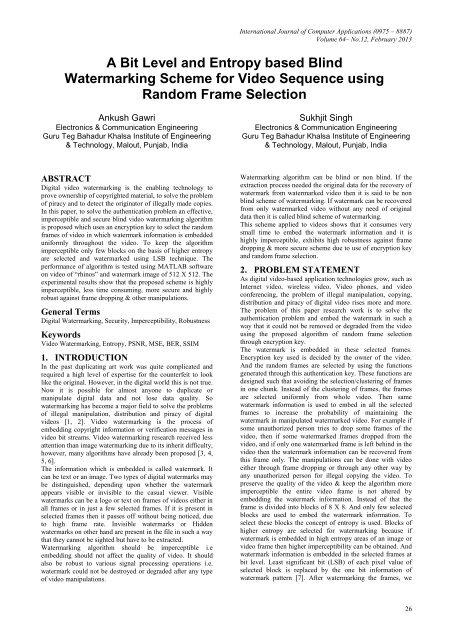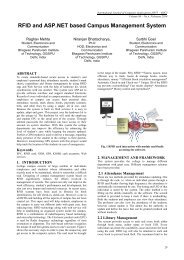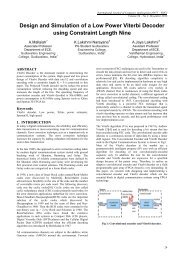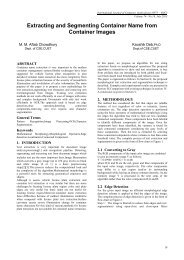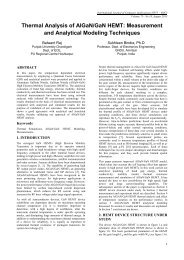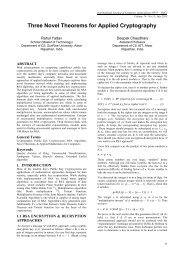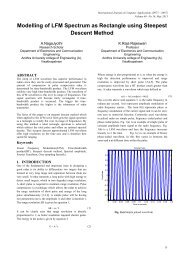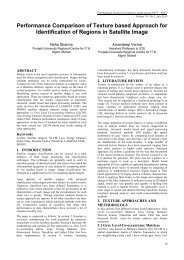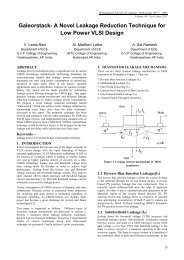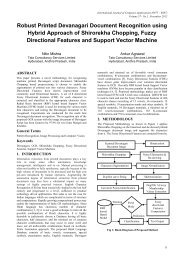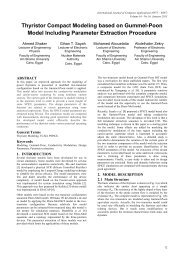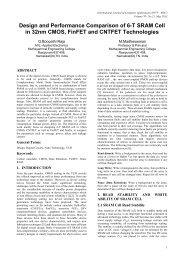A Bit Level and Entropy based Blind Watermarking Scheme for ...
A Bit Level and Entropy based Blind Watermarking Scheme for ...
A Bit Level and Entropy based Blind Watermarking Scheme for ...
You also want an ePaper? Increase the reach of your titles
YUMPU automatically turns print PDFs into web optimized ePapers that Google loves.
International Journal of Computer Applications (0975 – 8887)<br />
Volume 64– No.12, February 2013<br />
A <strong>Bit</strong> <strong>Level</strong> <strong>and</strong> <strong>Entropy</strong> <strong>based</strong> <strong>Blind</strong><br />
<strong>Watermarking</strong> <strong>Scheme</strong> <strong>for</strong> Video Sequence using<br />
R<strong>and</strong>om Frame Selection<br />
Ankush Gawri<br />
Electronics & Communication Engineering<br />
Guru Teg Bahadur Khalsa Institute of Engineering<br />
& Technology, Malout, Punjab, India<br />
Sukhjit Singh<br />
Electronics & Communication Engineering<br />
Guru Teg Bahadur Khalsa Institute of Engineering<br />
& Technology, Malout, Punjab, India<br />
ABSTRACT<br />
Digital video watermarking is the enabling technology to<br />
prove ownership of copyrighted material, to solve the problem<br />
of piracy <strong>and</strong> to detect the originator of illegally made copies.<br />
In this paper, to solve the authentication problem an effective,<br />
imperceptible <strong>and</strong> secure blind video watermarking algorithm<br />
is proposed which uses an encryption key to select the r<strong>and</strong>om<br />
frames of video in which watermark in<strong>for</strong>mation is embedded<br />
uni<strong>for</strong>mly throughout the video. To keep the algorithm<br />
imperceptible only few blocks on the basis of higher entropy<br />
are selected <strong>and</strong> watermarked using LSB technique. The<br />
per<strong>for</strong>mance of algorithm is tested using MATLAB software<br />
on video of “rhinos” <strong>and</strong> watermark image of 512 X 512. The<br />
experimental results show that the proposed scheme is highly<br />
imperceptible, less time consuming, more secure <strong>and</strong> highly<br />
robust against frame dropping & other manipulations.<br />
General Terms<br />
Digital <strong>Watermarking</strong>, Security, Imperceptibility, Robustness<br />
Keywords<br />
Video <strong>Watermarking</strong>, <strong>Entropy</strong>, PSNR, MSE, BER, SSIM<br />
1. INTRODUCTION<br />
In the past duplicating art work was quite complicated <strong>and</strong><br />
required a high level of expertise <strong>for</strong> the counterfeit to look<br />
like the original. However, in the digital world this is not true.<br />
Now it is possible <strong>for</strong> almost anyone to duplicate or<br />
manipulate digital data <strong>and</strong> not lose data quality. So<br />
watermarking has become a major field to solve the problems<br />
of illegal manipulation, distribution <strong>and</strong> piracy of digital<br />
videos [1, 2]. Video watermarking is the process of<br />
embedding copyright in<strong>for</strong>mation or verification messages in<br />
video bit streams. Video watermarking research received less<br />
attention than image watermarking due to its inherit difficulty,<br />
however, many algorithms have already been proposed [3, 4,<br />
5, 6].<br />
The in<strong>for</strong>mation which is embedded is called watermark. It<br />
can be text or an image. Two types of digital watermarks may<br />
be distinguished, depending upon whether the watermark<br />
appears visible or invisible to the casual viewer. Visible<br />
watermarks can be a logo or text on frames of videos either in<br />
all frames or in just a few selected frames. If it is present in<br />
selected frames then it passes off without being noticed, due<br />
to high frame rate. Invisible watermarks or Hidden<br />
watermarks on other h<strong>and</strong> are present in the file in such a way<br />
that they cannot be sighted but have to be extracted.<br />
<strong>Watermarking</strong> algorithm should be imperceptible i.e<br />
embedding should not affect the quality of video. It should<br />
also be robust to various signal processing operations i.e.<br />
watermark could not be destroyed or degraded after any type<br />
of video manipulations.<br />
<strong>Watermarking</strong> algorithm can be blind or non blind. If the<br />
extraction process needed the original data <strong>for</strong> the recovery of<br />
watermark from watermarked video then it is said to be non<br />
blind scheme of watermarking. If watermark can be recovered<br />
from only watermarked video without any need of original<br />
data then it is called blind scheme of watermarking.<br />
This scheme applied to videos shows that it consumes very<br />
small time to embed the watermark in<strong>for</strong>mation <strong>and</strong> it is<br />
highly imperceptible, exhibits high robustness against frame<br />
dropping & more secure scheme due to use of encryption key<br />
<strong>and</strong> r<strong>and</strong>om frame selection.<br />
2. PROBLEM STATEMENT<br />
As digital video-<strong>based</strong> application technologies grow, such as<br />
Internet video, wireless video, Video phones, <strong>and</strong> video<br />
conferencing, the problem of illegal manipulation, copying,<br />
distribution <strong>and</strong> piracy of digital video rises more <strong>and</strong> more.<br />
The problem of this paper research work is to solve the<br />
authentication problem <strong>and</strong> embed the watermark in such a<br />
way that it could not be removed or degraded from the video<br />
using the proposed algorithm of r<strong>and</strong>om frame selection<br />
through encryption key.<br />
The watermark is embedded in these selected frames.<br />
Encryption key used is decided by the owner of the video.<br />
And the r<strong>and</strong>om frames are selected by using the functions<br />
generated through this authentication key. These functions are<br />
designed such that avoiding the selection/clustering of frames<br />
in one chunk. Instead of the clustering of frames, the frames<br />
are selected uni<strong>for</strong>mly from whole video. Then same<br />
watermark in<strong>for</strong>mation is used to embed in all the selected<br />
frames to increase the probability of maintaining the<br />
watermark in manipulated watermarked video. For example if<br />
some unauthorized person tries to drop some frames of the<br />
video, then if some watermarked frames dropped from the<br />
video, <strong>and</strong> if only one watermarked frame is left behind in the<br />
video then the watermark in<strong>for</strong>mation can be recovered from<br />
this frame only. The manipulations can be done with video<br />
either through frame dropping or through any other way by<br />
any unauthorized person <strong>for</strong> illegal copying the video. To<br />
preserve the quality of the video & keep the algorithm more<br />
imperceptible the entire video frame is not altered by<br />
embedding the watermark in<strong>for</strong>mation. Instead of that the<br />
frame is divided into blocks of 8 X 8. And only few selected<br />
blocks are used to embed the watermark in<strong>for</strong>mation. To<br />
select these blocks the concept of entropy is used. Blocks of<br />
higher entropy are selected <strong>for</strong> watermarking because if<br />
watermark is embedded in high entropy areas of an image or<br />
video frame then higher imperceptibility can be obtained. And<br />
watermark in<strong>for</strong>mation is embedded in the selected frames at<br />
bit level. Least significant bit (LSB) of each pixel value of<br />
selected block is replaced by the one bit in<strong>for</strong>mation of<br />
watermark pattern [7]. After watermarking the frames, we<br />
26
International Journal of Computer Applications (0975 – 8887)<br />
Volume 64– No.12, February 2013<br />
insert them back in the video at their respective places to get<br />
the watermarked video.<br />
To extract the watermark from watermarked frames again<br />
same encryption key is required to find the watermarked<br />
frames. We set up a key identifier to give only three trials to<br />
the user. If the use tries extraction with more than 3 wrong<br />
keys then it is assumed that he is trying to find the<br />
watermarked frames by trying r<strong>and</strong>om keys. So at fourth try<br />
with wrong key the video is corrupted leaving no data behind.<br />
3. THEORETICAL BACKGROUND<br />
The proposed work requires certain theoretical considerations<br />
related to the concept of <strong>Entropy</strong> & its per<strong>for</strong>mance<br />
parameters. The following sections contain a brief description<br />
of these concepts.<br />
3.1 <strong>Entropy</strong><br />
There are many ways with which texture of multidimensional<br />
frame could be measured. <strong>Entropy</strong> is most suitable way to<br />
measure the texture content of an image or a video frame.<br />
Texture provides measures of properties of a frame such as<br />
smoothness, coarseness <strong>and</strong> regularity. Higher the entropy,<br />
least will be that part visible to human because human eye is<br />
insensitive to these high entropy areas. Hence, if watermark is<br />
embedded in high entropy areas of an image or video frame<br />
then higher imperceptibility can be obtained. <strong>Entropy</strong> is a<br />
statistical measure of r<strong>and</strong>omness that can be used to<br />
characterize the texture of the input image or video frame. Let<br />
P contains the histogram counts. The entropy is represented as<br />
(1)<br />
3.2 Per<strong>for</strong>mance measures<br />
Imperceptibility, robustness, security, complexity & data<br />
payload are considered as per<strong>for</strong>mance parameters <strong>for</strong> the<br />
proposed watermarking Algorithm.<br />
3.2.1 Imperceptibility<br />
Imperceptibility means that the perceived quality of the video<br />
should not be distorted by the presence of the watermark. As a<br />
measure of the quality of a watermarked video, <strong>Bit</strong> Error Rate<br />
(BER), Peak Signal to Noise Ratio (PSNR), Mean Squared<br />
Error (MSE) <strong>and</strong> Structural Similarity Index Metric (SSIM) is<br />
calculated between the original video frame <strong>and</strong> the<br />
corresponding watermarked frame [8].<br />
3.2.1.1 Mean squared error (MSE)<br />
To measure the similarity between the original video frame<br />
<strong>and</strong> watermarked frame an error signal is computed by<br />
subtracting the watermarked frame from the original frame,<br />
<strong>and</strong> then computing the average energy of the error signal.<br />
The MSE is given by equation<br />
(2)<br />
Where x(i, j) is represents the pixel values of original video<br />
frame <strong>and</strong> y(i, j) represents the corresponding pixel values of<br />
watermarked frame <strong>and</strong> i <strong>and</strong> j are the pixel position of the<br />
M×N image.<br />
MSE is zero when x(i, j) = y(i, j)<br />
3.2.1.2 Peak signal to noise ratio (PSNR)<br />
The PSNR is evaluated in decibels <strong>and</strong> is inversely<br />
proportional the Mean Squared Error. It is given by the<br />
equation<br />
(3)<br />
Higher the value of PSNR better is the quality of the<br />
watermarked frame.<br />
3.2.1.3 <strong>Bit</strong> error rate (BER)<br />
BER is the reciprocal of the PSNR.<br />
(4)<br />
The value of BER which is closer to zero represents more<br />
quality of the watermarked frame.<br />
3.2.1.4 Structural Similarity Index Metric (SSIM)<br />
The structural similarity (SSIM) index is a method <strong>for</strong><br />
measuring the similarity between the original video frame <strong>and</strong><br />
watermarked frame. The SSIM index is a full reference<br />
metric, in other words, the measuring of quality <strong>based</strong> on an<br />
initial distortion-free original frame as reference. The<br />
difference with respect to other techniques mentioned<br />
previously such as MSE or PSNR, is that these approaches<br />
estimate perceived errors on the other h<strong>and</strong> SSIM considers<br />
frame degradation as perceived change in structural<br />
in<strong>for</strong>mation. Structural in<strong>for</strong>mation is the idea that the pixels<br />
have strong inter-dependencies especially when they are<br />
spatially close. These dependencies carry important<br />
in<strong>for</strong>mation about the structure of the objects in the visual<br />
scene.<br />
The SSIM metric is calculated on various windows of any<br />
frame. The measure between two windows <strong>and</strong> of<br />
common size N×N is:<br />
Where C1 & C2 are constants.<br />
are given as:<br />
(6)<br />
(7)<br />
(8)<br />
(9)<br />
(10)<br />
(5)<br />
SSIM value closer to 1 represents the better quality of<br />
watermarked video.<br />
3.2.2 Security<br />
Security describes if the embedded watermarking in<strong>for</strong>mation<br />
cannot be removed beyond reliable detection.<br />
3.2.3 Complexity<br />
Complexity describes the ef<strong>for</strong>t <strong>and</strong> time we need <strong>for</strong><br />
watermark embedding <strong>and</strong> retrieval video. Another aspect<br />
addresses if we need the original data in the retrieval process<br />
or not i.e. the watermarking algorithm is non-blind or blind<br />
which influence the complexity.<br />
27
International Journal of Computer Applications (0975 – 8887)<br />
Volume 64– No.12, February 2013<br />
3.2.4 Capacity/Payload<br />
It describes how many in<strong>for</strong>mation bits can be embedded.<br />
3.2.5 Robustness<br />
Robustness describes if the watermark can be reliably<br />
extracted from the watermarked video [3, 5]. We can say<br />
Robustness of a watermarking algorithm is a measure of the<br />
immunity or resistance of the watermark against attempts to<br />
remove or degrade it from the video manipulations by<br />
different types of digital signal processing attacks. The<br />
similarity between the original watermark <strong>and</strong> the extracted<br />
watermark from the watermarked video can be measured by<br />
using the correlation factor<br />
following Equation:<br />
, which is computed using the<br />
(11)<br />
Where is a pixel of original watermark <strong>and</strong> is a<br />
pixel of the recovered watermark of size M X N.<br />
The correlation factor ρ may take values between 0 <strong>and</strong>1. The<br />
value closer to 1 represents the more similarity between the<br />
original watermark <strong>and</strong> extracted watermark.<br />
4. PROPOSED ALGORITHM<br />
In our proposed algorithm, entropy concept is used <strong>for</strong><br />
embedding watermark. And watermarking is per<strong>for</strong>med at bit<br />
level. The input video sequence is divided into its constituted<br />
frames. Then 10 r<strong>and</strong>om frames are selected through the<br />
functions generated using encryption key entered by owner of<br />
the video. Then the frame to be watermarked is divided into<br />
blocks of 8 X 8 <strong>and</strong> entropy is calculated <strong>for</strong> each block. The<br />
blocks with higher entropies are selected <strong>for</strong> embedding<br />
watermark. The embedding <strong>and</strong> extraction process of<br />
watermark is given in Figure 1. The embedding <strong>and</strong> extraction<br />
algorithm is given below in detail.<br />
4.1 Watermark Embedding Algorithm<br />
Step 1: Extract all the frames N from input video file.<br />
Step 2: Enter 10 digit encryption key <strong>for</strong> r<strong>and</strong>om frame<br />
selection where each digit of key is 8bit.<br />
Step 3: Calculate an offset value using total number of frames<br />
in video <strong>for</strong> uni<strong>for</strong>m selection of frames.<br />
(12)<br />
Step 4: Using the ASCII values of 10 digits of the key entered<br />
in step 2 & offset value calculated in step 3 to generate 10<br />
r<strong>and</strong>om functions to select 10 r<strong>and</strong>om frames from the video<br />
<strong>for</strong> watermarking. If the digits of key are a, b, c, d, e, f, g, h, i,<br />
j then the 10 functions will be<br />
If addition of ASCII values of two digits is greater than the<br />
offset value, then offset value is subtracted from their sum to<br />
get a number which is less than offset value. These 10 values<br />
of to represent the frame number. Frames with these<br />
frame numbers are selected <strong>for</strong> watermarking.<br />
Step 5: Select the blue component from the selected RGB<br />
frame in which the watermark is to be embedded.<br />
Step 6: Divide the blue component into blocks of size<br />
8X8. And find the entropy <strong>for</strong> each block <strong>and</strong> also find the<br />
threshold value.<br />
Step 7: Select the 8 X 8 blocks <strong>for</strong> watermarking whose<br />
entropy value is greater than threshold value<br />
Step 8: Rescale the watermark image as per the count of the<br />
selected blocks so that the size of the watermark will match<br />
with the total size of selected blocks <strong>for</strong> embedding.<br />
Step 9: Divide the watermark into the blocks of size 8X8<br />
Step 10: Embed the watermark blocks from step 10 into<br />
the selected blocks from step 7. For embedding replace<br />
the binary bits of the watermark block with the LSB of<br />
each corresponding pixel of block . In all watermarked<br />
blocks replace any fixed position pixel value with zero.<br />
Step 11: Rearrange these modified blocks at their respective<br />
position <strong>and</strong> integrate all 8 X 8 blocks to get watermarked<br />
blue component.<br />
Step 12: Integrate this modified blue component with red <strong>and</strong><br />
green components to get the watermarked RGB Frame.<br />
Step 13: Repeat step 5 to step 12 <strong>for</strong> all the selected frames<br />
<strong>for</strong> watermarking to get the watermarked frames.<br />
Step 14: Generate the checksum from the key used in step 2<br />
<strong>and</strong> store the checksum bits into the r<strong>and</strong>om pixels of the red<br />
component of frame 1. Set the first pixel value to zero in the<br />
red component of frame 2.<br />
Step 15: Develop the watermarked video using the modified<br />
frames by placing them to their respective position.<br />
4.2 Watermark Extraction Algorithm<br />
Step 1: Extract all the frames N from watermarked video file.<br />
Step 2: Ask the user to enter the encryption key.<br />
Step 3: Generate the checksum from the key entered by the<br />
user in step 2.<br />
Step 4: Extract the checksum of original key stored in the red<br />
component of frame 1.<br />
28
International Journal of Computer Applications (0975 – 8887)<br />
Volume 64– No.12, February 2013<br />
‘N’ Video Frames<br />
10 R<strong>and</strong>om Frames selected<br />
<strong>for</strong> watermarking<br />
Embedding of Watermark<br />
Video File 1<br />
N<br />
Frame 1<br />
Frame 2<br />
Blue Component<br />
of Frame<br />
Frame 3<br />
Divide into 8X 8<br />
Blocks<br />
Frame 10<br />
Calculate <strong>Entropy</strong><br />
10 Digit<br />
Encryption Key<br />
Generate Functions to<br />
select 10 R<strong>and</strong>om<br />
Frames<br />
Watermark Image<br />
size 512 X 512<br />
Count Selected<br />
Blocks<br />
Find Threshold<br />
Value<br />
Select Blocks with<br />
entropy > Threshold<br />
Watermarked<br />
Video File<br />
Placement of watermarked<br />
frames to their respective<br />
position<br />
1<br />
N<br />
Watermark<br />
Image of size<br />
512 X 512<br />
Watermarked Frame 1<br />
Watermarked Frame 2<br />
Rescale<br />
Watermark Image<br />
Watermarked Frame 3<br />
Embedding<br />
Process<br />
Rearrange & Integrate<br />
Blocks & Get watermarked<br />
Blue Component<br />
N<br />
Watermarked Frame 10<br />
Extracted Frames<br />
10 Watermarked Frames<br />
Extraction of Watermark<br />
1<br />
N<br />
N<br />
Generate Functions to<br />
select 10 watermarked<br />
Frames<br />
Watermarked Frame 1<br />
Watermarked Frame 2<br />
Watermarked Frame 3<br />
Watermarked Frame 10<br />
Blue Component of<br />
Watermarked Frame<br />
Divide into 8 X 8<br />
Blocks<br />
Select Watermarked<br />
Blocks<br />
10 Digit<br />
Encryption Key<br />
Extraction Process<br />
Extracted<br />
Watermark Image<br />
Rearrangement & Integration<br />
of Extracted Blocks<br />
Extracted Watermark Block 1<br />
Extracted Watermark Block 2<br />
Extracted Watermark Block N<br />
Figure 1: Watermark Embedding <strong>and</strong> Extraction Process<br />
29
International Journal of Computer Applications (0975 – 8887)<br />
Volume 64– No.12, February 2013<br />
Step 5: Compare both the checksums from step 3 & step 4.<br />
And increment the first pixel value in the red component of<br />
frame 2 every time checksum goes wrong.<br />
Step 6: When this pixel value reaches four then corrupt the<br />
video file by writing zero to all pixel values of video. And<br />
stop the extraction process.<br />
Step 7: If checksum matches then use the key entered in step<br />
2 <strong>for</strong> finding the watermarked frames in the video. Follow<br />
step 4 of embedding process to find the watermarked frames.<br />
Step 8: Select the blue component of watermarked frame<br />
from which the watermark is to be extracted.<br />
Step 9: Divide the blue component into blocks of size 8 X 8.<br />
Step 10: Out of these blocks select the watermarked blocks by<br />
checking zero in the fixed position pixel.<br />
Step 11: Extract the watermark blocks from these<br />
watermarked blocks. Read the LSB of each pixel value of<br />
watermarked Block to extract the corresponding bit of<br />
watermark block.<br />
Step 12: Rearrange all the extracted watermark blocks to get<br />
the extracted watermark image<br />
Step 13: Rescale the extracted watermark image to the size of<br />
original watermark image<br />
5. EXPERIMENTAL RESULTS AND<br />
PERFORMANCE EVALUATION<br />
MATLAB 7.10.0 is used as the plat<strong>for</strong>m <strong>for</strong> implementing the<br />
proposed work & conducting experiments. The per<strong>for</strong>mance<br />
of the proposed video watermarking algorithm is evaluated<br />
using many colored videos containing different number of<br />
frames at various frame rates. But here results are discussed<br />
<strong>for</strong> a 7.6 seconds video clip of “rhinos” at a frame rate of<br />
15fps constituting of 114 frames. The watermark used in our<br />
experiments was a binary image of 512 X 512. Encryption<br />
key used is “GAWRI@8146” <strong>based</strong> on which r<strong>and</strong>om frames<br />
are selected. A video frame, watermark image &<br />
corresponding watermarked frame is shown in figure 2.<br />
Figure 2: Original Video Frame, Watermark Image &<br />
Watermarked Frame<br />
5.1 Imperceptibility per<strong>for</strong>mance:<br />
To prove the proposed algorithm imperceptible, as a measure<br />
of quality of the watermarked video Mean Squared Error<br />
(MSE), Peak Signal to Noise Ratio (PSNR), <strong>Bit</strong> Error Rate<br />
(BER) <strong>and</strong> Structural Similarity Index Metric (SSIM) is<br />
calculated using equations (2), (3), (4), (5) respectively <strong>for</strong> all<br />
the watermarked frames. The values <strong>for</strong> these parameters <strong>for</strong><br />
all the frames & their average values are tabulated in table 1.<br />
Figure 3, 4, 5, 6 shows the values of MSE, PSNR, BER <strong>and</strong><br />
SSIM respectively <strong>for</strong> all the watermarked frames. Figure 7<br />
shows the average values of these parameters. Higher average<br />
value of PSNR (64.57 dB), smaller values of MSE (0.0227) &<br />
BER (0.015) <strong>and</strong> value of SSIM (0.9583) closer to 1 shows<br />
the imperceptibility of proposed algorithm.<br />
5.2 Security<br />
The proposed algorithm is more secure than the conventional<br />
algorithms due to the use of an encryption key <strong>for</strong> the<br />
selection of the frames to be watermarked. And at time of<br />
extraction process same encryption key is needed <strong>and</strong> if key is<br />
wrong then nobody can find the watermarked frames. And if<br />
someone tries <strong>for</strong> extraction with wrong key then he will be<br />
given only three chances of extraction, after that watermarked<br />
video will be damaged due to illegal processing <strong>and</strong> video will<br />
be of no use <strong>for</strong> that person.<br />
5.3 Complexity<br />
The proposed algorithm is very simple <strong>and</strong> blind algorithm as<br />
<strong>for</strong> extracting process it doesn’t require any original data to<br />
recover the watermark. And watermark can be extracted from<br />
only watermarked video.<br />
5.4 Embedding Time:<br />
Time consumed by the proposed watermarking algorithm is<br />
very small <strong>and</strong> is independent of the total video time because<br />
the frames to be watermarked are fixed. In proposed algorithm<br />
we are selecting 10 frames <strong>for</strong> watermarking. The considered<br />
video of “rhinos” is of 7.6 seconds. The frame extraction time<br />
is 6.60 seconds, frame reassembling time is 4.74 seconds <strong>and</strong><br />
time consumed <strong>for</strong> watermarking of 10 frames is 24.57<br />
seconds so total time consumed <strong>for</strong> whole embedding process<br />
is 35.91 seconds. If the video size is increased then the frame<br />
extraction & frame reassembling time increases but the<br />
watermarking time remains same which is approximately 25-<br />
30 seconds.<br />
5.5 Data Payload<br />
In proposed algorithm 8 X 8 blocks with high entropy are<br />
selected <strong>for</strong> watermark embedding. And one bit is embedded<br />
in one pixel i.e. total of 64 bits can be embedded in a selected<br />
blocks. Experiments are per<strong>for</strong>med on a frame size of 512 X<br />
512. So there are total 4096 blocks of a frame out of which<br />
minimum 2101 high entropy blocks are selected <strong>for</strong> data<br />
embedding <strong>and</strong> so minimum 1,34,464 bits can be embedded<br />
per frame.<br />
5.6 Robustness Per<strong>for</strong>mance<br />
Similarity between the original watermark <strong>and</strong> the extracted<br />
watermarks from all the watermarked video frames is<br />
measured by computing correlation factor ρ using the<br />
equation (11). R<strong>and</strong>om watermarked frame numbers are listed<br />
in table 1 & the extracted watermarks from respective frames<br />
are shown in figure 8. Original watermark & their correlation<br />
factor is also shown in figure 8.<br />
The proposed algorithm is more robust to frame dropping as<br />
well as other attacks than the conventional methods. Because<br />
to destroy the watermark from watermarked frames, the<br />
watermark frames should be known. And the watermarked<br />
frames cannot be found out easily due to r<strong>and</strong>om & uni<strong>for</strong>m<br />
frame selection <strong>for</strong> watermarking using the encryption key.<br />
Watermark is not embedded in the frames of one chunk but it<br />
is spread uni<strong>for</strong>mly throughout the video to avoid the<br />
30
International Journal of Computer Applications (0975 – 8887)<br />
Volume 64– No.12, February 2013<br />
clustering of watermarked frames in one chunk. Also in<br />
proposed algorithm same watermark image is embedded in all<br />
the frames due to which if watermark is destroyed in some<br />
watermarked frames by any manipulation or some<br />
watermarked frames are dropped then it can be recovered<br />
from the others <strong>and</strong> probability of maintaining the watermark<br />
in manipulated watermarked video increases.<br />
Figure 3: MSE Values <strong>for</strong> all the watermarked frames<br />
Figure 4: PSNR Values <strong>for</strong> all the watermarked frames<br />
Figure 5: BER Values <strong>for</strong> all the watermarked frames<br />
31
International Journal of Computer Applications (0975 – 8887)<br />
Volume 64– No.12, February 2013<br />
Figure 6: SSIM Values <strong>for</strong> all the watermarked frames<br />
Figure 7: Average Values of PSNR, MSE, BER & SSIM of All the Frames<br />
Watermarked<br />
Frame<br />
Frame<br />
1<br />
Table 1: Values of MSE, PSNR, BER, SSIM <strong>for</strong> all the Frames & their average<br />
Frame<br />
2<br />
Frame<br />
3<br />
Frame<br />
4<br />
Frame<br />
5<br />
Frame<br />
6<br />
Frame<br />
7<br />
Frame<br />
8<br />
Frame<br />
9<br />
Frame<br />
10<br />
Average<br />
Value<br />
R<strong>and</strong>om<br />
Frame<br />
4 20 26 34 49 65 76 84 94 103 NA<br />
Number<br />
MSE 0.020086 0.021062 0.024153 0.023933 0.025127 0.022009 0.022107 0.024077 0.02298 0.021897 0.022743<br />
PSNR 65.1019 64.8959 64.3012 64.3409 64.1295 64.7049 64.6856 64.3148 64.5173 64.727 64.5719<br />
BER 0.015361 0.015409 0.015552 0.015542 0.015593 0.015455 0.015459 0.015549 0.0155 0.01545 0.015487<br />
SSIM 0.98325 0.97515 0.97039 0.95488 0.94991 0.93977 0.94663 0.94403 0.94856 0.97098 0.95836<br />
32
International Journal of Computer Applications (0975 – 8887)<br />
Volume 64– No.12, February 2013<br />
Figure 8: original watermark, extracted watermarks from all the 10 watermarked frames with frame number & their<br />
correlation factors<br />
6. CONCLUSIONS<br />
In this paper, a blind video watermarking algorithm is<br />
proposed in which r<strong>and</strong>om frames from the whole video<br />
frames are selected <strong>for</strong> watermarking using an encryption key.<br />
To preserve the quality of the video, a particular selected<br />
frame is divided into blocks <strong>and</strong> the blocks of high entropies<br />
are selected <strong>for</strong> watermarking. Then watermark in<strong>for</strong>mation is<br />
embedded at LSB of each pixel of the selected block. The<br />
algorithm is evaluated in terms of imperceptibility, security,<br />
time consumption, data payload <strong>and</strong> robustness. To measure<br />
the imperceptibility of algorithm PSNR, MSE, BER & SSIM<br />
are computed. The calculated values of these parameters show<br />
the high imperceptibility of the algorithm. Also the algorithm<br />
is simple blind algorithm, less time consuming, more secure<br />
<strong>and</strong> highly robust against frame dropping & other<br />
manipulations.<br />
7. REFERENCES<br />
[1] L. Qiao <strong>and</strong> K. Nahrstedt, "<strong>Watermarking</strong> <strong>Scheme</strong>s <strong>and</strong><br />
Protocols For Protecting Rightful Ownership <strong>and</strong><br />
Customer's Rights", Journal of Visual Commun. <strong>and</strong><br />
Image Represent 9, pp.194– 210, 1998.<br />
[2] M. Arnold, M. Schumucker, <strong>and</strong> S. Wolthusen,<br />
“Techniques <strong>and</strong> Applications of Digital <strong>Watermarking</strong><br />
<strong>and</strong> Content Protection”. Artech House, 2003.<br />
[3] Lama Rajab, Tahani Al-Khatib, Ali Al-Haj, “Video<br />
<strong>Watermarking</strong> Algorithms Using the SVD Trans<strong>for</strong>m”<br />
European Journal of Scientific Research, Vol.30 No.3,<br />
pp.389-401, 2009.<br />
[4] Manek<strong>and</strong>an. GRS, Franklin Rajkumar. V, “A Robust<br />
<strong>Watermarking</strong> <strong>Scheme</strong> <strong>for</strong> Digital Video Sequence using<br />
<strong>Entropy</strong> <strong>and</strong> Hadamard Trans<strong>for</strong>mation Technique”,<br />
International Journal of Computer Applications, Volume<br />
41– No.18, pp.24-31, March 2012.<br />
[5] Angshumi Sarma, Amrita Ganguly, “An <strong>Entropy</strong> <strong>based</strong><br />
Video <strong>Watermarking</strong> <strong>Scheme</strong>”, International Journal of<br />
Computer Applications, Volume 50 – No.7, pp.24-31,<br />
July 2012.<br />
[6] Jigar Madia, Kapil Dave, Vivek Sampat, Parag Toprani,<br />
“Video <strong>Watermarking</strong> using Dynamic Frame Selection<br />
Technique”, National Conference on Advancement of<br />
Technologies – In<strong>for</strong>mation Systems & Computer<br />
Networks (ISCON – 2012), pp.31-34, 2012.<br />
[7] Jassim Mohmmed Ahmed, Zulkarnain Md Ali,<br />
“In<strong>for</strong>mation Hiding using LSB technique”, International<br />
Journal of Computer Science <strong>and</strong> Network Security,<br />
VOL.11 No.4, pp.18-25, April 2011.<br />
[8] C.Sasi varnan, A.Jagan, Jaspreet Kaur, Divya Jyoti,<br />
Dr.D.S.Rao, “Image Quality Assessment Techniques on<br />
Spatial Domain”, IJCST Vol. 2, Issue 3, pp. 177-184,<br />
September 2011<br />
33


